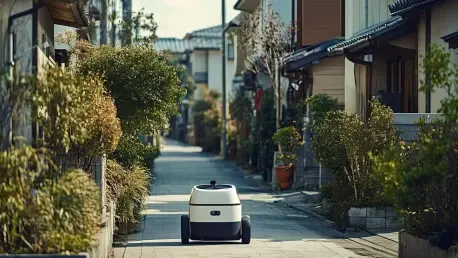As the world moves towards an era dominated by technology, delivery robots are rapidly gaining traction, reshaping how goods are transported in urban landscapes and remote areas alike. Recent developments in robotics, artificial intelligence, and advanced navigation systems are accelerating the integration of autonomous delivery systems into various sectors. Ranging from logistics to healthcare and retail, these systems are becoming essential in the landscape of last-mile delivery, offering solutions to labor shortages and rising operational costs. The Covid-19 pandemic brought these innovations into the limelight, underscoring the benefits of contactless delivery and reducing human interaction. While the potential for growth in this field is vast, numerous challenges remain, particularly concerning implementation costs and technical hurdles.
Technology and Efficiency
Robotics and AI Advancements
Delivery robots are equipped with state-of-the-art technologies that make them effective in urban and challenging terrains, fostering remarkable shifts in global logistics. These autonomous machines use sophisticated algorithms and sensors to navigate complex environments, dodge obstacles, and deliver packages with precision. Artificial intelligence lies at the core of this functionality, enhancing decision-making and adaptability in real time. Such developments have increased the performance capabilities of delivery robots, initiating a paradigm shift in logistics operations that prioritize speed and accuracy. Cities worldwide are the prime beneficiaries, with robotic systems effectively alleviating traffic congestion and labor constraints.
Moreover, robotics in delivery serve the dual purpose of reducing costs and minimizing environmental impacts, creating more sustainable supply chains. Energy-efficient designs and the use of recyclable materials in manufacturing are integral aspects of today’s robot development. Manufacturers aim not only to comply with environmental regulations but also to enhance the reputation of automation technologies while leveraging government incentives. These initiatives contribute to the overall efficiency of logistics operations, paving the way for greener methods of transport and distribution.
Cost and Operational Challenges
Despite potential advantages, the deployment of delivery robots is not without hurdles, particularly for small and medium-sized enterprises (SMEs). The upfront investment needed for acquiring and implementing robotic delivery systems can be substantial, impacting the scale at which smaller businesses can adopt such technologies. Additionally, operational costs, including maintenance and upgrades, pose recurring challenges requiring strategic planning and resource allocation. While larger corporations might navigate these obstacles with relative ease, SMEs often face difficulties in managing the financial demands associated with robotic integration.
However, these barriers are gradually diminishing as technology advances and becomes more accessible. The declining cost of components and software associated with robotic systems encourages widespread adoption across diverse industries. Companies capable of offering scalable, customizable solutions tailored to specific market needs have a unique opportunity to capitalize on these trends. Emerging markets in regions like Asia-Pacific, Latin America, and the Middle East provide fertile ground for expansion due to rapid urbanization and governmental support for automation, presenting significant growth potential.
Market Growth and Sustainability
Emerging Market Opportunities
The global delivery robot market presents promising growth prospects, especially in emerging economies due to urbanization and governmental support. In countries across Asia-Pacific, Latin America, Africa, and the Middle East, the increasing need for efficient logistics solutions is driving demand for innovative delivery technologies. Governments in these regions often promote automation as a means to modernize infrastructures and improve economic productivity. This support creates opportunities for businesses to invest in the development of tailored delivery systems that meet specific local needs, thereby enhancing market penetration.
Moreover, as urban landscapes evolve, maintaining efficient logistics becomes essential for sustaining economic growth amid fluctuating labor dynamics. Delivery robots fit into these environments seamlessly by bridging gaps caused by labor shortages and rising costs. Businesses that proactively address local challenges by integrating adaptable robotic delivery systems gain competitive advantages while also contributing to the technological upliftment of these regions. These strategies promote efficient logistics operations and foster sustainable economic growth.
Focus on Sustainability
Sustainability continues to be a priority in the robotic delivery sector, influencing innovations throughout development and deployment. Manufacturers increasingly emphasize energy-efficient designs and the utilization of recyclable materials, reducing environmental footprints while meeting regulatory mandates. Despite the prevalent cost concerns, the advantages that arise from aligning with eco-friendly standards are substantial, ranging from improved brand image to securing governmental incentives. Businesses adopting sustainable practices not only adhere to environmental directives but also capitalize on burgeoning consumer demand for green technology.
With sustainability intertwined with these advancements, companies stand poised to fulfill zero-emission goals while navigating evolving regulations. The drive for sustainable delivery solutions encourages manufacturers to innovate continually, ensuring that robotic systems maintain ecological balance alongside operational efficiency. This alignment not only bolsters business objectives but also propels industries toward a future where logistics contribute positively to broader environmental agendas.
Advancing Global Logistics
Equipped with cutting-edge technology, delivery robots are transforming logistics globally, conquering urban and challenging landscapes with ease. These autonomous devices rely on advanced algorithms and state-of-the-art sensors to skillfully negotiate complex environments, avoid obstacles, and deliver packages accurately. At the heart of these capabilities is artificial intelligence, which enhances real-time decision-making and adaptability, leading to a significant shift in logistics operations that prioritize speed and accuracy. Cities worldwide benefit the most as these robotic systems help ease traffic congestion and mitigate labor shortages.
In addition, the use of robots for delivery helps cut costs and reduce environmental impacts, making supply chains more sustainable. Energy-efficient designs and recyclable materials are integral in today’s robotic development. Manufacturers strive to meet environmental standards while improving the image of automation technologies and benefiting from governmental incentives. These advancements boost the overall efficiency of logistics, paving the way for greener transportation and distribution methods.









